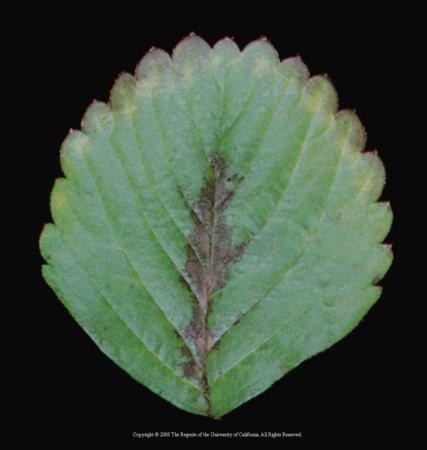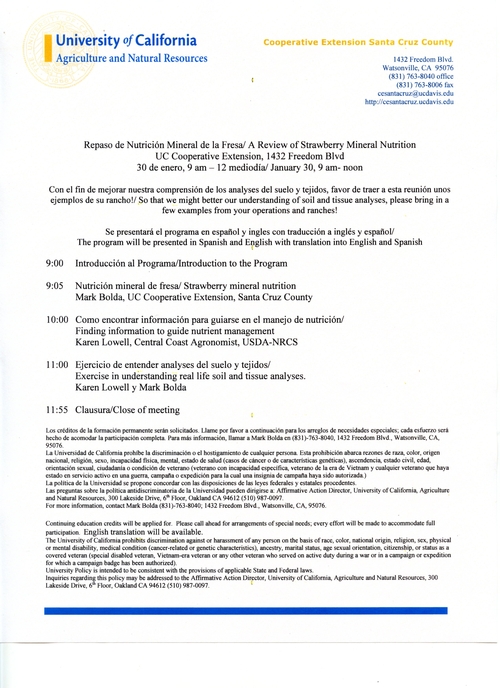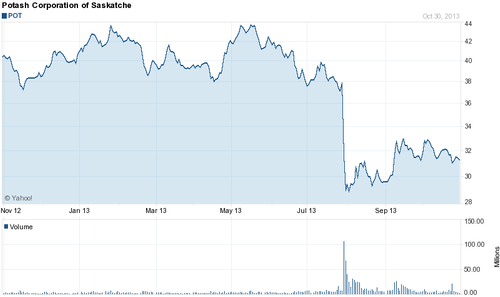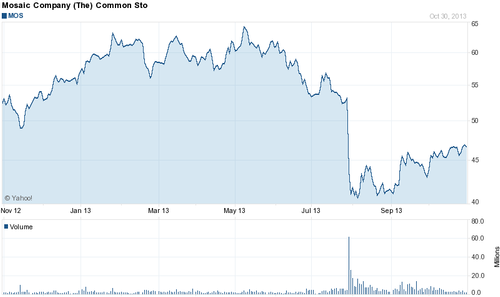
Posts Tagged: potassium
Potassium and Disease in Berries
Continuing on with my perusal of the relation of fertility and plant disease out of the excellent “Mineral Nutrition and Plant Disease” by looking at potassium (K) this week. For the record, while I do a lot of reading in this area lately, don't get the impression that this is all I read about! For example I recently finished reading “The Iliad” written by the poet Homer (not in the original Greek though).
There is actually not that much to say about the relationship of potassium and plant disease. The only thing that came out of this chapter that could be relevant to us berry people is that K fertilization has been shown to reduce the severity of vascular wilts in several crop plants caused by Verticillium, but only in situations when it is deficient in the soil. When K is sufficient (something around 200 ppm K and above) in the soil, the disease mitigation benefit of potassium additions is not realized. Too, the effectiveness of the K additions is going to depend on the host plant resistance to the disease, as well as the amount of disease inoculum in the soil.
Bottom line is I'm not seeing a lot for us here. Most of our soils on the Central Coast are close to 200 ppm K or well above (see the link to an excellent survey in the Salinas Valley below), so a benefit in the way of vascular disease resistance through the use of more potassium fertilizer doesn't seem to hold a lot of promise.
//ucanr.edu/blogs/blogcore/postdetail.cfm?postnum=6029
Potassium Nutrition of Plant and Soil
We haven't spent much time in this space discussing the plant nutrient potassium (K), because my experience here on the Central Coast in berries is that it rarely shows up as a deficiency. Be that as it may, when UCCE colleague Scott Stoddard (UCCE Farm Advisor in Merced County) recently gave a webinar on this very material together with Compass Minerals, I jumped on the chance to learn more about it.
Potassium in the Plant: Potassium varies in plants depending on age and physiological maturity. A good way to check whether plants are getting enough is to take leaf samples. According to the DRIS work in strawberry I did with UCCE Specialist Tim Hartz and Farm Advisor Mark Gaskell, 1.8 to 2.2% K in the leaf prior to harvest, and 1.3 to 1.8% K during harvest indicates sufficiency in the plants. Note that these levels are for whole leaves, not petioles. Leaf concentrations for caneberries are likely to be pretty close to these, but this has not been empirically investigated in California. Of all the nutrients essential to plant growth, the concentrations of K in the tissue are only surpassed by nitrogen. K is all over in the plant, and some 60% of it is found in the chloroplasts. Since plants, as with nitrogen and phosphorous, will mine their older leaves to move these macronutrients to the younger leaves, K deficiency will first show up in the older leaves. Typical symptoms are white speckling and yellowing and necrosis on leaf margins.
The fruit are also a major sink for this nutrient. For example, in strawberry some 3.7 lbs K2O per acre are removed for every ton of fruit harvested (according to the USDA, raw strawberries contain 153 mg of K per 100 g of fruit), meaning that an average crop yield of strawberries of 6000 ten lb crates is removing 110 lbs K2O per acre.
Potassium in the Soil: Availability in the soil of K to the plant is mediated by many factors including cation exchange capacity (CEC), type of clay, amount of exchangeable K, soil moisture, soil pH, temperatures and to an extent the genetics and developmental stage of the plant. Plant available K exists in the soil in three forms: soil solution K (usually 1 ppm – 10 ppm, which is not nearly enough for plants), exchangeable K (the form of K usually measured by soil tests, mostly found in concentrations of 30-300 ppm, 30 ppm being deficient and 300 ppm being high) and fixed, non-exchangeable K (around 1000 ppm). An equilibrium exists between these three forms, meaning that as the easily available soil solution K is taken up by the plant, it is readily buffered (replaced) by exchangeable K, followed by a more slow buffering and replacement by non-exchangeable K. A laboratory soil test for potassium (ammonium acetate test) measures the soil solution plus exchangeable K. However, it is important to remember that a potassium soil test is a useful but imperfect indicator of K availability to plants. There are situations when supplemental K may be needed even when the soil tests high.
Interference by other Soil Cations: The cations magnesium (Mg), calcium (Ca) and sodium (Na) all can all interfere with plant uptake of K by competing for binding sites in the soil. High alkalinity (high pH), calcareous soils can be cause of a problem with Ca, and Scott shares that soil Mg at 10 times the amount of K (converted to millimole equivalents) can be a source of interference problems as well. For example, research by UC Extensionist Specialist Dr. Tim Hartz and UCCE Farm Advisor Gene Miyao in processing tomatoes has found that if K accounts for less than 2% of the soil CEC, yield and fruit color improve from fertilizer K. In soils deficient in K, or in soils where K is sufficient but Mg is elevated, the magnesium can replace potassium on the exchange complex. Tomatoes have yellow shoulders and melons are soft.
That being said, note that most crops are very resilient to wide ranges of nutrient ratios, and in most areas south of the Sacramento Delta, magnesium has no negative impacts on strawberry production, nor is it commonly known to have negative impacts on strawberry production on the Central Coast.

Leaflet of potassium-deficient strawberry; note the darkening at the margins which can eventually lead to necrosis. Darkening may develop along the midvein, near the base of the leaflet. Photo from "Strawberry Deficiency Symptoms" Ulrich et al. UC ANR Bulletin 1917.
UCCE Potassium Webinar
Pretty interesting looking webinar on potassium as a plant nutrient coming up this March 19. I've already signed up - it's free and the presenter, UC Cooperative Extension's Scott Stoddard, knows this stuff really well. Should be time well spent:
Announcing a Meeting on January 30 on Strawberry Mineral Nutrition
This post is to announce a meeting on strawberry mineral nutrition to take place this coming January 30. I think it might be good to spend a little bit of time on the current salt situation as well, seeing as it is related to nutrition and water.
First presentation will be in Spanish, and the second in English, with translation provided for both.
Growers and PCA's - bring a copy soil and/or tissue sample analysis for review of sufficiencies/deficiencies/toxicities in our final exercise.
Look forward to seeing you there!

MG156
Will the Breakup of the Potash Cartel from the former Soviet Union Affect Berry Cost of Production?
This past July the Russian potash producer OAO Uralkali threw the global potash market for a loop by halting its long running cooperation in what was essentially a cartel with the Belorusian owned producer Belaruskali, enabling it to now produce potash flat out and very likely gain a lot of market share. Not incidentally this move has landed the CEO of Uralkali in house arrest for abuse of power and embezzlement. Whatever the case may be, this decision has turned an oligopoly for potassium supply into a much freer market, and has consequently sent potash prices plummeting, crushing the shares of several listed American potash distributors in the process (Graphic 1 and 2 below).
In numbers, Uralkali plans on increasing production of potash from 10.5 million pounds this year to 13 million next year, out of a total global market of some 50 million pounds per year. According to Bloomberg, this separation of the two companies should bring the price of potash from above $400 a ton before July, 2013 to approximately $300 a ton.
What does this mean for local berry producers? Probably not a lot. First, potassium is a tiny proportion of berry cost of production of the already small cost of fertility at under 2% of the total. Second, if my experience and lots of soil and tissue samples serve me right, there is not much necessity for adding much more potassium to many of our soils! After decades of potassium fertilizer additions, this non-mobile nutrient has built up to astonishing levels in many of our fields (adequacy of K in soil in usually thought of being 200-300 ppm and in leaf tissue above 1.3% during the harvest season), meaning in most cases that required additions are quite small.
Contrast this with the case of the Central Valley for producers of heavy potassium feeding crops such as almonds for example. Scanning the Cost of Production studies for almonds, we find that annual potassium fertilizer use resides north of 5% of total costs of production, not to mention that the “potassium gravy train is coming to an end” for many other crops of the San Joaquin Valley in the words of Dr. Tim Hartz of UC Davis, with the decades long draw down of what were formerly potassium rich soils. Might be a good time for these growers to start loading that potassium back up again while prices are down.

Shares of Potash Corporation pounded in late July after the break up of the Belorussian potash cartel - what does it mean for local berry producers?

Shares of the Mosaic Company down heavily in late July after the break up of the Belorussian potash cartel - maybe a good time to bring K deficient soils back to par.
